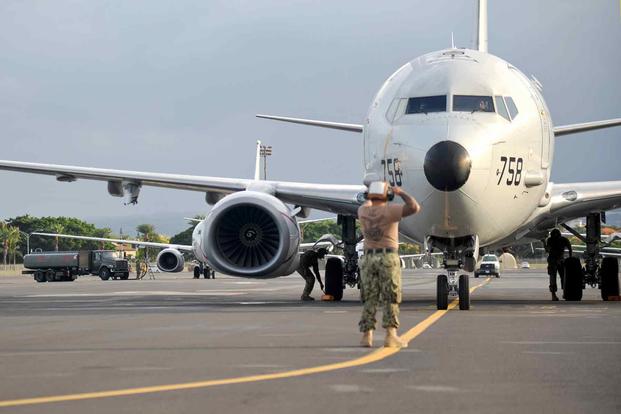The Defense Department's top watchdog wants to analyze whether the Navy's newest fleet of maritime surveillance aircraft is fully ready to hunt and track submarines near Europe, nearly seven years after achieving operational readiness in 2013.
In a letter sent to the service as well as U.S. European Command, the Inspector General's Office this week said it will begin a fact-finding investigation to determine "whether the readiness of U.S. Navy's P-8 Poseidon aircraft fleet meets the anti-submarine warfare requirements of [EUCOM]."
Officials said they will look to gather information from crews at Naval Air Systems Command, Patuxent River, Maryland; Commander Patrol and Reconnaissance Group, Norfolk, Virginia; Patrol and Reconnaissance Wing 10, Naval Air Station Whidbey Island, Washington; Patrol and Reconnaissance Wing 11, Naval Air Station Jacksonville, Florida; U.S. European Command, Stuttgart, Germany; and U.S. Naval Forces Europe-Naval Forces Africa, Naples, Italy, according to the letter.
The news comes as the Navy investigates whether it can retrofit the P-8 to hold more ammunition at a time when adversary submarine activity -- particularly from the Russian navy -- is surging.
Related: Head of Global Strike Command Wants to Make Air Force Bombers Even More Lethal
The main mission of the P-8A, which replaced the Navy's P-3C Orion, is to track submarines by dropping buoys that ping, listen and detect. The intelligence-gathering aircraft is a Boeing-made adaptation of its 737 commercial aircraft.
The plane's 120 buoys are transported within cylindrical cases in the rear of the aircraft.
The on-board crew decides which it will drop based on weather and altitude, and they then monitor the data they collect. The aircraft also uses a mix of sophisticated GPS systems, radios, electronic warfare tools, communication nodes, infrared imaging and high-tech radars to detect things happening on or below the water's surface. Its lightweight AN/APY-10 radar, nestled within its "snoopy nose," can detect and classify threats at long ranges.
The aircraft can also strike: Crews can zero in on submarines to lob an MK-54 torpedo or AGM-84D Harpoon missile. The plane carries the missiles on its external wing pylons or in the weapons bay on the underside of the aircraft.
But it may be able to carry more. According to a presolicitation notice posted in January, the service wants to incorporate the AGM-158C Long Range Anti-Ship Missile (LRASM) onto the P-8, which has a greater-than-200 nautical mile standoff range, according to the weapon's maker, Lockheed Martin Corp. The precision-guided, anti-ship standoff missile first achieved early operational capability on the B-1B Lancer bomber in 2018. LRASM will be able to autonomously sensor-locate and track targets while avoiding friendly forces, Lockheed officials have said.
The potential expansion would boost the variety of the P-8's weapons stock as the Navy plans to cut back the size of the fleet. The Navy's 2021 fiscal budget request does not fund any more Poseidon patrol aircraft, capping out the total fleet to 117 aircraft instead of 138, according to Forbes.
Yet the spy aircraft has a vital mission, especially as hotspots around the world continue flaring up.
Specifically in Europe, submarines coming from the Barents Sea -- where Russia has a submarine hub near the Kola Peninsula -- tend to slip through the Greenland, Iceland, U.K. waterways, nicknamed "the GIUK," and into the Atlantic Ocean.
Speaking to reporters in February, Air Force Gen. Tod Wolters, the head of U.S. European Command who also serves as NATO's Supreme Allied Commander-Europe, said officials have observed "a 50% increase in the number of resources Russia committed to the undersea" activity between 2018 and 2019.
Allies and partners continue to acquire the aircraft.
Boeing delivered the first submarine-hunting and anti-surface warfare aircraft to the United Kingdom last fall. Australia already flies long-range aircraft, and the Indian Navy flies the P-8I variant. Norway has also bought into the program.
-- Oriana Pawlyk can be reached at oriana.pawlyk@military.com. Follow her on Twitter at @Oriana0214.
Read more: Army Debuts Redesigned Arctic Tab as It Shifts Focus to Cold-Weather Training













